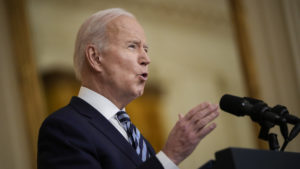- Wind farms are deflationary and capital costs reduce over time
- India is ahead of the trend, with solar and wind locked in at US$30 a megawatt hour
- Australia should look at building multiple offshore wind farms
The reason behind the rise of renewables in recent years turns out not to be so much about decarbonisation as it is about economics, according to Energy market analyst Tim Buckley.
“The hyperinflation in all forms of fossil fuel commodities have really accentuated the speed and need for an energy transition and decarbonisation,” he told Stockhead.
“In addition to the climate science, every government around the world is talking about supply chain security, they’re talking about energy security and conveniently, therefore, they’re talking about decarbonisation.
“And renewables are deflationary.”
Basically, with wind and solar you just have to build the infrastructure to capture the energy, and from there on out it’s freely available and capital costs fall over time – as opposed to ye olde fossil fuels where you have ongoing capital costs in exploration for new reserves and drilling wells.
India’s renewables deliver deflation
Buckley pointed to India as an example, with the energy minister announcing 1-3 gigawatt tenders and getting 5-10 gigawatts of investor appetite every month.
“The prices he was signing out was literally US$30 a megawatt hour in year one, but the contract was for zero inflation for the next 25 years,” he said.
“Now, go back two years ago, inflation in Australia was virtually unheard of, but in India, inflation was 5-7% per annum.
“This means not only was he locking in solar and wind at US$30 a megawatt hour – the cheapest in the world – but he was locking it in on a deflationary tariff and every year the real price was going to down by the rate of inflation because the nominal headline contract was flat.
“So, US$30 in year one becomes $28 in year two, becomes $26 in year three in real terms.”
And today where India is seeing the import coal price and import LNG price rise, any domestic renewable energy is delivering deflation.
It’s something Australia should consider, Buckley says.
“Now that we’re back to an inflationary environment, the value of the deflationary nature of renewable energies is really coming to the fore, as is energy security, as is supply chain security,” he said.
“In other words, we don’t want to be reliant on Chinese supply chains for magnets or for batteries, so therein lies the opportunity for Australia to be an alternative source of value-added manufacturing.”
Capital intensive but then you have price certainty
Buckley says that in the case of wind farms, it’s greenfield so while its capital intensive at the start, then you basically have 100% price certainty for the next 25 years.
However, these projects can take 2-4 years to get up and running, and there’s specific supply chain requirements for the turbines, with the blades alone often measuring in at around 50m long.
“The actual turbines are fibreglass, they’re specialty cast, they are very big and long so you have special transportation needs, you need special ships to actually assemble them offshore,” Buckley said.
“So, there’s a lot of supply chain issues and there’s a lot of very specific tailored equipment and manufacturing and assembly needs relating to turbines, more so than say a solar module where the scale is more rinse and repeat.”
Not to mention, the size of the turbines are getting bigger – and harder to transport.
“They’re getting much, much bigger – they’re doubling in size, and you can’t really ship turbines all around the world, particularly the blades, so there is a local content advantage,” Buckley says.
“But then there’s also a disadvantage in that if you’re only building one offshore wind farm then you’re going to build all the infrastructure, the supply chains and then only use them once.”
The way to get around this is to build multiple wind farms, he added. That way you get the supply chain and more sequential manufacturing demand – which then means you can justify the first factory.
“Then you get the local jobs and the local employment and the local investment, but you don’t get that when you’re only building one offshore wind farm,” Buckley said.
Which ASX stocks have a direct stake in wind farms?
In turns out that every ASX player with a direct stake in wind is, well, a Kiwi.
MERIDIAN ENERGY (ASX:MEZ)
Meridian is New Zealand’s biggest power generator, with 100% of its energy coming from renewable sources, including seven wind farms and an eighth – Harapaki wind farm – being built.
“To ensure the smooth operation of a wind farm, there are a few buildings required – an operations and maintenance (O&M) building, and a substation are key,” project manager Robert Batters said.
“Soon the two transformers required for the wind farm will be arriving in New Zealand.
“The transformers take close to a year to be built, then require rigorous testing before they are transported by ship from South Korea.”
The O&M building and substation build are currently underway, along with the foundations for the whopping 41 turbines that will make up the wind farm.
MERCURY NZ (ASX:MCY)
Another New Zealand player, this company has four wind farms, and in December commissioned the northern sector of the Turitea Wind Farm, which will be the largest in the country once built.
Plus, the company picked up Tilt New Zealand’s wind operations in August last year (after they delisted) and the acquisition is already paying off.
The company generated almost 7,500GWh in FY2022 bolstered by wind generation of 1,269GWh from Turitea North and the ex-Tilt wind farms.
“In less than 12 months we have become New Zealand’s largest wind generator after having no operating wind generation at the start of the year,” chair Prue Flacks said.
“Decarbonisation will underpin significant growth for Mercury over the coming decade. With a scale retail business now contributing substantial forward revenue and a strong portfolio of existing and prospective generation assets, we expect to meaningfully contribute to emissions reduction.”
INFRATIL (ASX:IFT)
Okay, this one is a Kiwi too, but it’s not directly a renewable player.
Instead, Infratil is an infrastructure investment company with a heavy focus on renewables, airports, healthcare, and digital infrastructure.
The company has a stake in New Zealand’s Manawa Energy, who have more than 30 new solar and wind developments under active consideration, with enhancement uplifts to existing generation assets currently on track to deliver more than 67GWh per year of additional generation on top of FY22’s 1,760GWh generation production volumes.
IFT also has a slice of US-based Longroad Energy, who are targeting 4.5GW of new generation and storage over the next three years.
Plus, the company has a 40% stake in Swiss-based Galileo, who develops wind and solar photovoltaic energy projects and storage solutions across Europe, including in its largest markets, Italy, Spain, France, Germany and the UK.
Galileo currently has a development pipeline of over 3GW and is targeting developing 300 to 500MW of this pipeline annually.
MEZ, MCY and IFT Share prices today:
You might be interested in












